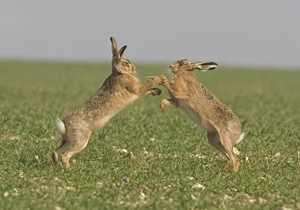Brown hare (Lepus europaeus)
 Mad March Hare time is here again – when hares can be seen chasing each other around the fields and on occasions, standing face to face on their hind legs and “boxing” with their front paws and then leaping high into the air and kicking out with their powerful hind legs, which often results in lumps of fur floating off across the field in the breeze.
Mad March Hare time is here again – when hares can be seen chasing each other around the fields and on occasions, standing face to face on their hind legs and “boxing” with their front paws and then leaping high into the air and kicking out with their powerful hind legs, which often results in lumps of fur floating off across the field in the breeze.
Although this is sometimes two males squabbling over a female, more often than not it is a female warding off an amorous male as she is not yet ready to mate. For those of you who have witnessed these boxing events, you must agree it is wonderfully entertaining and surely must be one of the great annual displays that the spring season has to offer.
The female or “jill” (the male is called a “jack”) can produce young in any month and often has three litters a year, although April and May are the peak of the breeding season, and she usually produces between two to four leverets per litter, which are born fully covered in fur and have their eyes wide open, unlike rabbits, which are born naked and blind. Soon after they are born, the jill moves the leverets to separate scrapes that she has made in the ground, known as “forms” where they will hide for the first month of their lives until they are weaned. The jill will only visit the leverets once in every 24 hours, calling them to her as she approaches, usually about an hour after sunset, and staying with them for just five minutes – long enough for them to suckle her milk.
What a lonely introduction to life – left completely alone within a short time of birth in a new and unfamiliar landscape, not only at the mercy of predators such as foxes, dogs and buzzards, but also farm machinery and severe weather such as a thunderstorm - but there they patiently wait in the hope that their mother will return to nourish them. This may appear to be the absolute minimum that a mother could do for her young, but the less she visits them the less chance there is for her to lead a predator to them. They will not meet their father during these early stages as he takes no part at all in their upbringing, although they may of course have to compete with him in later life.
Adult hares will rest up during the day in forms usually created well out in the middle of fields, where they will have scraped out a number of these shallow hollows, facing in various directions, allowing them to choose one that faces into the wind so that they can use their acute sense of smell to detect any danger that may be about. Their eyes are set far back on the side of the head, which enables them to monitor the rest of the circumference around them.
Very occasionally, when evading a predator, the “blind” spot normally covered by the nose, can let them down and they have been known to run straight into a person, which as they can often weigh over 5kgs and reach speeds of 35 miles per hour, can be quite a thump! However, because they can see behind, they know precisely when their pursuer is about to catch them, causing them to suddenly jink and turn, leaving the hunter once again lagging behind. Because hares have big, long, powerful back legs but rather short, comparatively weak front legs, they can run uphill much more easily than downhill and so usually when flushed they will set off up the slope.
Peter Thompson
Advisory

Download Peter Thompson's essential 26-page book, featuring beautiful photography and detailed profiles of Britain's wildlife
Download FREE >